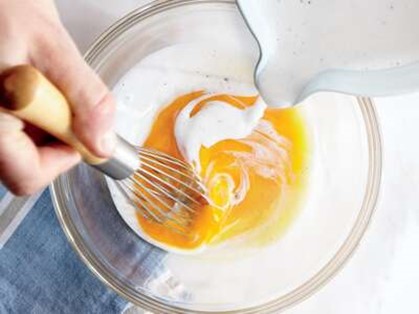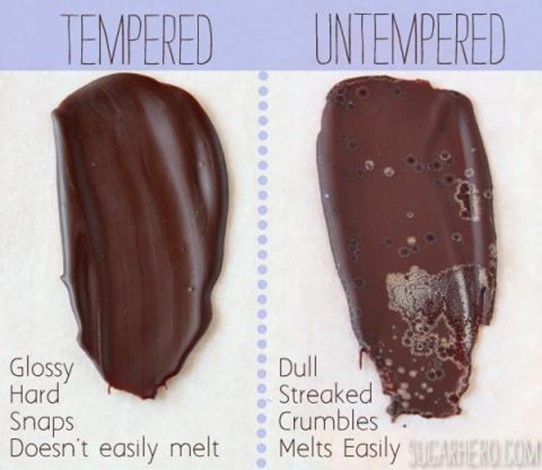All About Tempering
It’s likely that many of our Cook’n readers know all All About Tempering. But because Cook’n gathers new readers every day, some of whom might be newbies to cooking, I’m going to talk about it. Here’s everything you ever need to know All About Tempering, according to Sarah Phillips of CraftyBaking.com.

Sarah explains that tempering is the process of slowly bringing up the temperature of an ingredient that’s sensitive to heat (such as eggs, milk and other dairy products, and even chocolate) before you add it to other ingredients in your recipe. This important process prevents it from curdling, breaking (separating), or cooking too fast.
Chances are, even if you aren’t acquainted with tempering, you’ve used the technique, if you’ve ever made beef stroganoff. Stroganoff recipes typically call for sour cream, or cream cheese and cream or whole milk. Tempering assures your base sauce will be thick, smooth, and creamy.
When tempering eggs with hot milk, you add a small portion or measured portions of the hot component (say milk) to the cooler ingredient (the eggs) in a small bowl, and stir it thoroughly in. Then you add this now-warmed ingredient to the rest of the hot component (hot milk in the large pot) and stir well.

Examples of recipes that call for tempered eggs would be dessert recipes such as flan, lemon curd, cream pie, pastry cream, crème brûlée, homemade ice cream, pastry cream, crème anglaise, soufflés, and eggnog. Recipes like carbonara sauce, avgolemono, and hollandaise sauce also require tempered eggs.
This technique slowly raises the temperature of the eggs, without heating them through (which can result in a cooked egg). The time it takes to temper an ingredient is well worth it—it’s the difference between success and failure of your end product.

I just made a pot of fresh cream of mushroom soup this morning (for tonight’s dinner), and sure enough, the recipe called for tempering the sour cream before I added it to the very hot mushroom/chicken stock. The recipe directions said exactly what Sarah explained above, that “…tempering will prevent the sour cream from breaking and will result in a creamier soup.”
Finally, tempering is also used when adding melted chocolate to a recipe, where you want to bring down the temperature of the chocolate so it won't “seize” when added to the much cooler batter or recipe.

Chocolate becomes “seized” when what you're melting comes into contact with moisture. Chocolate itself doesn't contain any moisture, so adding a small amount of liquid can disrupt the melting process. A seized chocolate may taste the same, but it doesn’t look nice or handle well.
I’ll close with the recipe I made this morning. It was easy and fairly fast, considering this was my first attempt at making it. I can say right now, it’ll be a keeper—every taste test was delicious!

1 tablespoon extra virgin olive oil
1/2 cup onions diced small
2 cloves garlic diced small
1 (8-ounce) package sliced white mushrooms (or other mushrooms of choice)
1 1/2 cups chicken, beef, mushroom or vegetable stock or broth (Better than Bullion or bullion cube/powder also works when mixed with water according to label directions)
1/4 teaspoon thyme
1/4 teaspoon rosemary
1/4 teaspoon black pepper
salt to taste
1 cup sour cream
2 tablespoons all-purpose flour
1 tablespoon fresh chopped parsley for garnish (optional)
Directions:
Add Recipe to Cook'n

Sarah explains that tempering is the process of slowly bringing up the temperature of an ingredient that’s sensitive to heat (such as eggs, milk and other dairy products, and even chocolate) before you add it to other ingredients in your recipe. This important process prevents it from curdling, breaking (separating), or cooking too fast.
Chances are, even if you aren’t acquainted with tempering, you’ve used the technique, if you’ve ever made beef stroganoff. Stroganoff recipes typically call for sour cream, or cream cheese and cream or whole milk. Tempering assures your base sauce will be thick, smooth, and creamy.
When tempering eggs with hot milk, you add a small portion or measured portions of the hot component (say milk) to the cooler ingredient (the eggs) in a small bowl, and stir it thoroughly in. Then you add this now-warmed ingredient to the rest of the hot component (hot milk in the large pot) and stir well.

Examples of recipes that call for tempered eggs would be dessert recipes such as flan, lemon curd, cream pie, pastry cream, crème brûlée, homemade ice cream, pastry cream, crème anglaise, soufflés, and eggnog. Recipes like carbonara sauce, avgolemono, and hollandaise sauce also require tempered eggs.
This technique slowly raises the temperature of the eggs, without heating them through (which can result in a cooked egg). The time it takes to temper an ingredient is well worth it—it’s the difference between success and failure of your end product.

I just made a pot of fresh cream of mushroom soup this morning (for tonight’s dinner), and sure enough, the recipe called for tempering the sour cream before I added it to the very hot mushroom/chicken stock. The recipe directions said exactly what Sarah explained above, that “…tempering will prevent the sour cream from breaking and will result in a creamier soup.”
Finally, tempering is also used when adding melted chocolate to a recipe, where you want to bring down the temperature of the chocolate so it won't “seize” when added to the much cooler batter or recipe.

Chocolate becomes “seized” when what you're melting comes into contact with moisture. Chocolate itself doesn't contain any moisture, so adding a small amount of liquid can disrupt the melting process. A seized chocolate may taste the same, but it doesn’t look nice or handle well.
I’ll close with the recipe I made this morning. It was easy and fairly fast, considering this was my first attempt at making it. I can say right now, it’ll be a keeper—every taste test was delicious!

Fresh Mushroom Soup
Ingredients:
1 tablespoon extra virgin olive oil
1/2 cup onions diced small
2 cloves garlic diced small
1 (8-ounce) package sliced white mushrooms (or other mushrooms of choice)
1 1/2 cups chicken, beef, mushroom or vegetable stock or broth (Better than Bullion or bullion cube/powder also works when mixed with water according to label directions)
1/4 teaspoon thyme
1/4 teaspoon rosemary
1/4 teaspoon black pepper
salt to taste
1 cup sour cream
2 tablespoons all-purpose flour
1 tablespoon fresh chopped parsley for garnish (optional)
Directions:
1. In small dish, mix sour cream and flour. Set aside.
2. In soup pan, add extra virgin olive oil and onions. Sauté on medium/high heat until edges start to turn golden brown (about 2-3 minutes).
3. Add garlic and sauté for about 10-20 seconds (be careful not the burn the garlic as the pan will be hot when you add).
4. Add broth/stock and mushrooms to pot.
5. Sprinkle spices on top and stir to mix.
6. Bring mixture to a boil and cook until mushrooms are soft (about 3-4 minutes).
7. Transfer mixture to a heat safe bowl.
8. Allow to cool slightly, about 2-3 minutes. Add sour cream/flour mixture. TIP: See recipe card notes for extra step for extra creamy soup.
9. Mix thoroughly and enjoy!
NOTE: Take time to temper your sour cream. This extra step will prevent the mixture from breaking and will ensure an extra creamy soup.
PROCESS: Transfer about ½ cup on the hot liquid into a separate heat-safe bowl. Stir in your sour/cream flour mixture until thoroughly mixed. Gradually add in the rest of the hot liquid mixture and keep stirring. Add the remainder of mixture (mushrooms, onions, etc.) and finish stirring.
2. In soup pan, add extra virgin olive oil and onions. Sauté on medium/high heat until edges start to turn golden brown (about 2-3 minutes).
3. Add garlic and sauté for about 10-20 seconds (be careful not the burn the garlic as the pan will be hot when you add).
4. Add broth/stock and mushrooms to pot.
5. Sprinkle spices on top and stir to mix.
6. Bring mixture to a boil and cook until mushrooms are soft (about 3-4 minutes).
7. Transfer mixture to a heat safe bowl.
8. Allow to cool slightly, about 2-3 minutes. Add sour cream/flour mixture. TIP: See recipe card notes for extra step for extra creamy soup.
9. Mix thoroughly and enjoy!
NOTE: Take time to temper your sour cream. This extra step will prevent the mixture from breaking and will ensure an extra creamy soup.
PROCESS: Transfer about ½ cup on the hot liquid into a separate heat-safe bowl. Stir in your sour/cream flour mixture until thoroughly mixed. Gradually add in the rest of the hot liquid mixture and keep stirring. Add the remainder of mixture (mushrooms, onions, etc.) and finish stirring.
Recipe formatted with the Cook'n Recipe Software from DVO Enterprises.
 Alice Osborne
Alice Osborne
Weekly Newsletter Contributor since 2006
Email the author! alice@dvo.com
